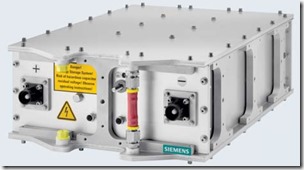Capacitors - Energy Storage Application

Siemens, Sitars ESM 125 Water
Cooled Energy Storage Module
Key Specifications:
-
Rated Voltage: 120 ... 125 V d.c.
-
Rated Capacitance: 63 F
-
Usable Energy Storage: 105 Wh
-
Usable Current Range: 150 ... 170 A d.c.
-
Maximum Series Module: 8
-
Operational Cycles: 1,000,000
Note: if disconnected then the energy will self discharge due to internal resistance in approximately four to five days.
Capacitors have numerous applications in electrical and electronic applications. This note examines the use of capacitors to store electrical energy. The sidebar shows details of a typical commercially available energy storage module.
Advantages & Disadvantages
In deciding the appropriateness of using capacitors as an energy storage medium, it is worth looking at some of the advantages and advantages:
Advantages:
- can charge and accumulate energy quickly
- can deliver the stored energy quickly
- losses are small compared to other storage medium
- long service life and low (or no) maintenance
Disadvantages:
- low energy capacity compared to batteries
- limited energy storage per dollar cost
- stored energy will eventually deplete due to internal losses
Note: some interesting schemes are being developed to overcome some of the disadvantages.
For example, Shanghai is experimenting with super capacitor buses, called the Capabus. Siemens is developing a hybrid storage utilising both capacitors and batteries to be used in the powering of light rail systems. In both these applications, capacitors are quickly charged at stops or along the route by connecting to overhead charging points.
Energy Storage
Double Layer Capacitors
Many energy storage modules will use electric double layer capacitors, often referred to as super capacitors.
Super capacitors use a liquid electrolyte and charcoal to form what is known as an electrical double layer. This greatly increases the capacitance. Capacitors with large Farad rating and small size can be obtained.
Note: due to having a large internal resistance, double layer capacitors are not suitable for a.c. circuits.
For anyone not familiar with capacitor theory or needing a quick refresher, please review the Capacitor Theory note.
The amount of energy (in joules) stored by a capacitor is determined by the capacitance (C) and voltage (V) and is given by:
The greater the capacitance or the voltage, the more energy it can store.
When connecting capacitors in series, the total capacitance reduces but the voltage rating increases. Connecting in parallel keeps the voltage rating the same but increases the total capacitance. Either way the total energy storage of any combination is simply the sum of the storage capacity of each individual capacitor.
Tip: one application of capacitors as part of a hybrid (capacitor/battery) energy system, is that they can help prolong battery life.
Energy Stored Example
Consider the above energy storage module (63 F at 125 V). What is the stored energy of one module by itself and then of two modules connected in series.
The energy of one module is:
by connecting two modules in series (doubling the voltage, halving the capacitance), the energy storage can be doubled:
Safety: capacitors store energy and will remain charged when disconnected from any supply. Before working on any capacitive systems which have been isolated from the power supply, be careful to take all necessary steps to ensure the capacitors are fully discharged.
Hybrid Energy Systems
Hybrid energy systems (HES) employ capacitors in conjunction with batteries or to benefit from the advantages of both technologies while minimizing the disadvantages.
Within a hybrid energy system the capacitors can charge and deliver energy more quickly, thereby reducing strenuous duties on the batteries. The batteries can achieve greater energy densities and provide for longer running duration.
The use of this type of hybrid energy systems is becoming more popular, particularly in transportation applications.
Hopefully, everyone now has a better understanding of using capacitor for energy storage. If anyone still has questions or any comments, please post below.
See Also